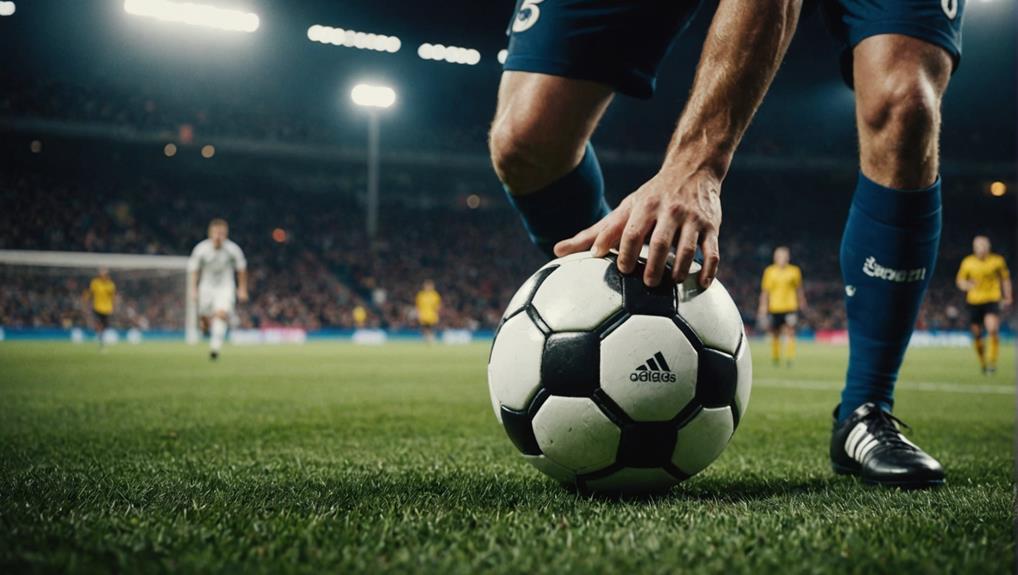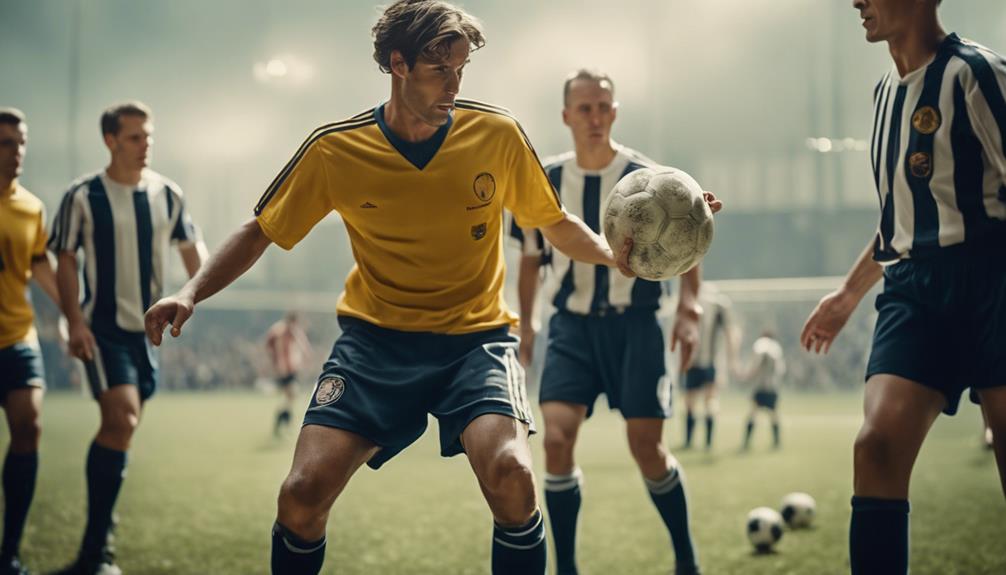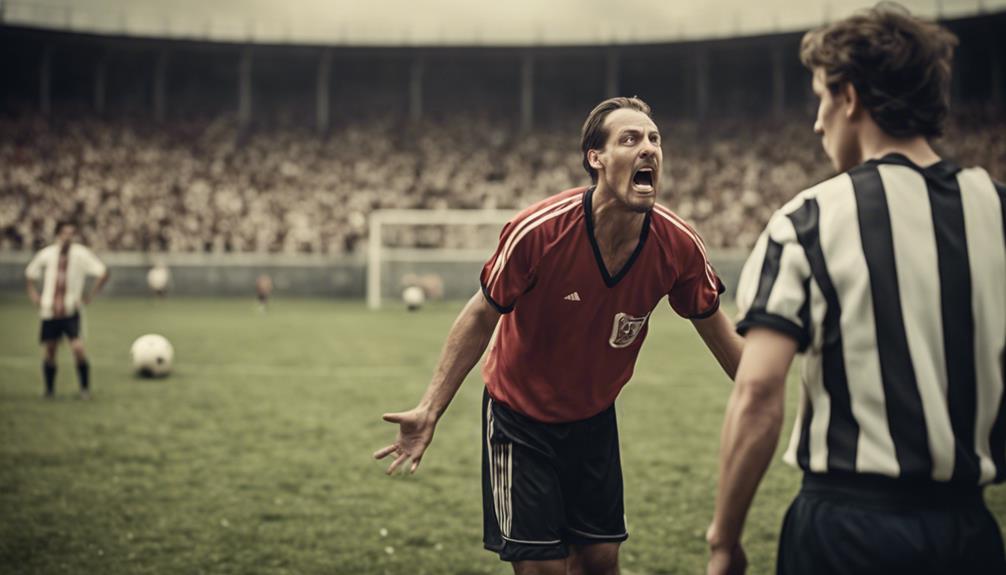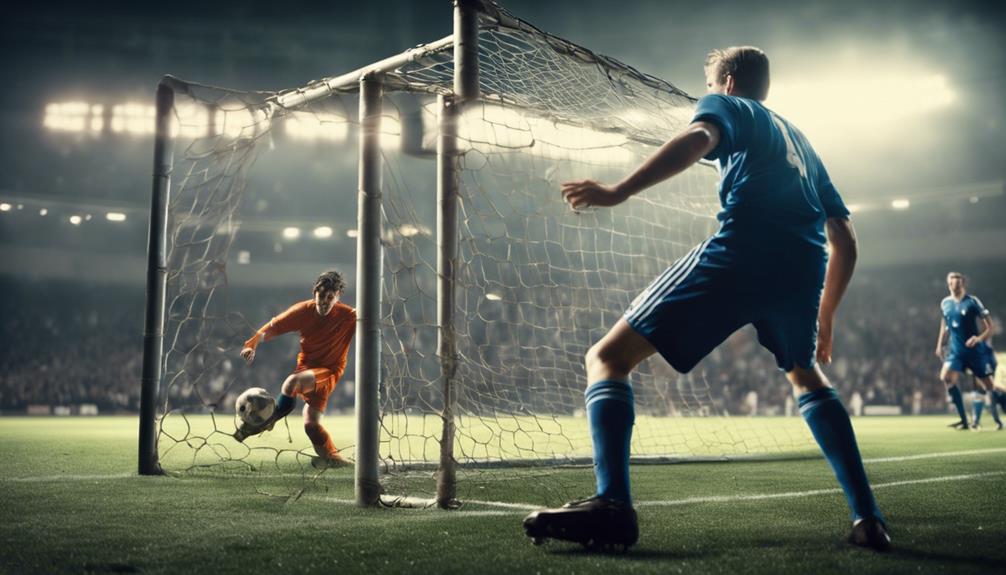
Hand Ball in Soccer: Rules and Controversies
August 3, 2024If you're a soccer enthusiast, understand that handball in soccer is when a player intentionally handles the ball with their hand or arm, except for certain body parts like the head, chest, or thigh. Actions like making your body bigger to block the ball are penalized. The severity dictates punishments, even red cards. The rules have evolved over time, with a focus on natural body positioning and accidental handballs. Exploring the controversies and nuances in handball rules can give you a deeper appreciation for how these regulations shape the beautiful game and influence match dynamics.
Definition of Handball in Soccer
Understanding what constitutes handball in soccer is vital for players, referees, and fans alike. In soccer, handball is defined as deliberately touching the ball with the hand or arm, except for specific body parts like the head, chest, or thigh.
It becomes an offense when a player makes their body unnaturally bigger to block the ball or directly scores a goal with the hand or arm. The upper boundary for handball offenses is typically considered to be the bottom of the armpit, with any contact above this line potentially resulting in a penalty.
The severity of the offense determines the punishment, with more serious infractions possibly leading to red cards for denying a goal-scoring opportunity. Distinguishing between intentional and accidental handball incidents is crucial in determining if a violation has occurred according to the Laws of the Game.
Evolution of Handball Laws
The evolution of handball laws in soccer has brought significant changes to address issues like unnatural body positions and accidental handball incidents. The adjustments made by IFAB in 2020/21 and 2021 reflect a proactive approach to ensuring fair play and reducing controversies surrounding handball calls.
- IFAB's introduction of the handball area above the sleeve line highlights the focus on unnatural body positions to determine handball offenses.
- The emphasis on accidental handballs in the recent rule changes showcases the impact of VAR and the ongoing debates on consistent enforcement.
- IFAB now penalizes handballs, even if unintentional, when the arm makes the body unnaturally bigger, aiming to reduce ambiguity in handball decisions.
- The continuous improvement in interpreting and enforcing handball rules underlines the necessity of ensuring consistent application across various leagues and competitions to address controversies effectively.
History and Significance of Handball Offense

You'll learn about the origins of the handball rule in soccer and how it has impacted goalkeeper regulations.
Understanding the historical significance of handball offenses can provide insight into the evolution of the game's rules over time.
Delving into the impact on goalkeepers will shed light on the intricacies of handball offenses in soccer.
Origin of Handball Rule
The establishment of the Laws of the Game in 1863 marked the origins of the handball rule in soccer, distinguishing it from rugby and shaping the regulations regarding handling the ball.
The introduction of the handball rule was essential in defining the unique identity of soccer as a sport separate from rugby. Here are some key points regarding the origin and evolution of the handball rule:
- Soccer's handball rule was implemented to prohibit players from handling the ball intentionally during gameplay.
- Initially, goalkeepers were permitted to handle the ball anywhere on the field until 1912, when specific handball rules were introduced for them.
- Over time, there have been gradual adaptations to the handball rule to secure its consistency and relevance in modern soccer.
- The evolution of handball rules has played a significant role in shaping the current regulations of the game, emphasizing fair play and skillful ball control.
Impact on Goalkeeper Rules
Exploring the evolution of goalkeeper rules in soccer sheds light on the historical development and importance of handball offenses in the sport. Until 1912, goalkeepers had free rein to handle the ball anywhere in their half. However, specific regulations governing goalkeeper handball persisted until 1992. These changes have greatly influenced the overall soccer regulations.
Notably, goalkeeper handball offenses are treated distinctly from those committed by outfield players during matches. To truly understand the importance of handball offenses in soccer, it's essential to dig into the historical context of goalkeeper handball rules. The alterations in rules concerning goalkeepers' ability to handle the ball have played a pivotal role in shaping the sport over the years.
Impact of Handball Rules on Matches
Moving through a soccer match, the influence of handball rules becomes evident in shaping the course of play and outcomes.
- Game Outcomes: Handball rules play an essential role in determining the final results of matches, as penalties awarded or denied can directly impact the scoreline.
- Player Behavior: Players have adjusted their behavior on the field to minimize the risk of handball incidents, altering their movements and strategies to comply with the regulations.
- Referee Decisions: Referees face heightened pressure to make accurate calls regarding handballs, with increased scrutiny leading to more interventions and potential game-changing decisions.
- Match Dynamics: Debates surrounding handball rulings continue to influence the overall dynamics of matches, as teams strategize and adapt their gameplay based on the interpretation of these rules.
The interplay of handball rules with player actions, referee judgments, and match strategies underscores the importance of these regulations in shaping the outcomes and experiences of soccer games.
Player Reactions and Future Outlook

Considering player reactions and future outlook on handball regulations in soccer, adjustments and discussions are shaping the landscape of the sport.
Players have had mixed responses to the strict interpretations of handball regulations, leading to changes in training strategies to avoid penalties. Some players have criticized the lack of standardized interpretations, which has contributed to confusion and controversy surrounding handball decisions.
To address these issues, advancements in technology like VAR are being utilized to assist referees in making more precise calls.
Looking ahead, there are ongoing discussions about potential future changes to handball regulations. The aim is to provide clearer guidelines, reduce controversies, and strive for the continuous evolution of handball regulations in soccer.
As players adapt their playing styles and officials aim for more consistency, the future of handball regulations in soccer is likely to see improvements that benefit the game as a whole.
Handball Rules in Soccer Leagues
Players in various soccer leagues must navigate the intricacies of handball rules, each league implementing its own interpretations and enforcement strategies. When it comes to handball, leagues like the Premier League, UEFA Champions League, and Serie A have specific criteria that determine offenses and penalties. Here are some key points to keep in mind:
- Variance in Penalty Percentages: Different leagues have varying penalty percentages for handball offenses, leading to controversies and debates among players, coaches, and fans.
- Enforcement Strategies: The rules regarding handball in each league contribute to differences in how penalties are enforced, affecting the outcome of games and player performances.
- Specific Criteria for Handball: The specific criteria, such as the boundary of the upper arm and intentional touches, play a significant role in determining whether a handball offense has occurred.
- Impact on Controversies: The enforcement of handball rules in soccer leagues often sparks controversies, with debates arising over the fairness and consistency of decisions made by referees and governing bodies.
Historical Evolution of Handball Rule

The historical evolution of handball rules in soccer showcases a progressive journey towards enhancing fairness and gameplay integrity.
Initially, before 1863, handling the ball was permissible, leading to the introduction of free-kick penalties for this offense.
Subsequently, rules regarding goalkeepers evolved, allowing them to handle the ball anywhere in their half until 1912 when restrictions were imposed.
Notable changes, such as prohibiting goalkeepers from picking up back passes, were implemented in 1992, shaping the modern handball rules we see today.
Throughout history, there have been continuous adjustments to the handball rule to ensure equity and uphold the integrity of the game.
This evolution reflects the sport's commitment to adapting to the changing dynamics of soccer while preserving the core principles of fair play.
As soccer progresses, the historical changes in handball rules serve as a testament to the sport's dedication to maintaining the integrity and spirit of the game.
Impact of VAR on Handball Calls
The introduction of VAR in soccer has greatly impacted handball calls, leading to increased scrutiny on these incidents since its implementation in 2018. This technology has revolutionized the way handball incidents are reviewed and adjudicated, influencing the outcomes of matches and sparking debates among fans and experts alike.
- Referees now have the assistance of VAR to guarantee accurate handball decisions, especially within the penalty area.
- Accidental handballs can result in penalties if the arm creates an unnatural body position, irrespective of the player's intent.
- Referee decisions regarding handballs are now based on the outcome of the incident rather than the player's intentions.
- Despite the increased accuracy in calls, controversial handball incidents continue to make headlines, showcasing the significant impact of VAR on the game.
The implementation of VAR has unquestionably brought more precision to handball calls, but it has also added a layer of complexity and controversy to the game, shaping the way these incidents are perceived and managed.
Denying Goal-Scoring Opportunity

When a player denies a clear goal-scoring opportunity through handball, they risk receiving a red card.
VAR technology plays a pivotal role in determining if a handball incident led to a goal-scoring chance being denied.
Understanding the impact of a red card for denying a goal-scoring opportunity is vital in modern soccer.
Red Card Impact
Denying a goal-scoring opportunity through a handball offense can result in a red card for the player involved. When a player intentionally handles the ball to prevent a clear goal-scoring chance, the referee must assess if a significant goal-scoring opportunity was denied.
Here's what you need to know about the red card impact in such scenarios:
- Referees issue a red card to players who commit an intentional handball to stop a goal-scoring chance.
- The offending player is dismissed from the match, leaving their team to play with a numerical disadvantage.
- The red card for denying a goal-scoring opportunity due to a handball offense has a significant impact on the outcome of soccer matches.
- It's essential for players to be aware of the consequences of such actions, as the red card not only affects the current game but could also lead to further disciplinary actions.
VAR Influence
VAR technology revolutionized the way handball incidents denying goal-scoring opportunities are reviewed and adjudicated in modern soccer. The VAR impact has been significant in determining whether a player should receive a red card for denying a clear goal-scoring opportunity through handball.
Referees now heavily rely on VAR reviews to make pivotal decisions, such as awarding a penalty kick or sending off a player for handball. The technology assists in identifying if a handball indeed prevented a clear goal-scoring opportunity, enhancing the accuracy of decision-making.
While VAR has brought more consistency to these rulings, it has also sparked controversy. The increased scrutiny on handball incidents due to VAR has stirred debates over the fairness and interpretation of the rules.
Despite the controversies, VAR's influence in addressing handball cases that deny goal-scoring chances has unquestionably changed the landscape of soccer officiating.
Proposed Changes and Recent Controversies
IFAB's proposed silhouette rule aims to clarify handball incidents by focusing on altering a player's body shape with hand/arm position to reduce ambiguity.
Recent controversies surrounding handball rules in football have increased the pressure on referees to interpret incidents correctly, highlighting the impact of proposed changes.
To address these challenges, efforts are ongoing to improve enforcement and ensure consistency in applying handball rules across soccer competitions.
Discussions and potential changes are expected in the future to enhance the clarity and fairness of the rules.
Conclusion
So, there you have it – the rules and controversies surrounding handball in soccer. It may seem like a game of inches, but one wrong move could change everything.
As fans, we can't help but feel like the handball rule is a bit of a double-edged sword. It's a tough call, but one thing's for sure – it keeps us on the edge of our seats every match.


